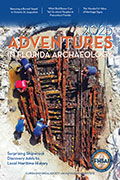Florida Frontiers Articles
Florida Frontiers: The Weekly Newspaper Articles of the Florida Historical Society is a weekly newspaper article covering history-based events, exhibitions, activities, places and people in Florida. The newspaper articles premiered in January 2014. We explore the relevance of Florida history to contemporary society and promote awareness of heritage and culture tourism options in the state.
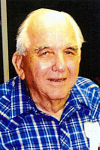
People who lived in Brevard County, Florida during the first half of the twentieth century will tell you shocking stories of dealing with mosquitos before DDT was developed as an insecticide. For example, they say that if you put your hand on a window screen on the shady side of a house, it took only a few seconds for the mosquitos to form a solid black mirror of your hand as they attempted to bite you through the wire mesh. Everyone had window screens, because there was no air conditioning.
... click title or here for the full article
The Florida Historical Society (FHS), whose statewide headquarters are in Cocoa Village, is announcing today the establishment of a new department focusing on the intersection of history and archaeology. March is Florida Archaeology Month and just in time for the celebration, FHS is launching the Florida Historical Society Archaeological Institute (FHSAI).
Established in 1856, the Florida Historical Society has been supporting archaeology in the state for more than a century.
FHS was the first state-wide organization dedicated to the preservation of Florida history and prehistory, as stated in their 1905 constitution. It was the first state-wide organization to preserve Native American artifacts such as stone pipes... click title or here for the full article

Carrying a cumbersome audio recorder that he called “the thing,” Stetson Kennedy traveled through rural backwoods, swamps, and small towns from north Florida to Key West, collecting oral histories, folktales, and work songs. He spoke with the diverse people of Florida including Cracker cowmen, Seminole Indians, Greek sponge divers, African American turpentine still workers, and Latin cigar rollers.
The result of Stetson Kennedy’s trek through Florida’s multicultural communities was the classic 1942 book Palmetto Country.
Born in Jacksonville in 1916, Stetson Kennedy traveled the world but always returned to Florida. He left his studies at the University of Florida in 1937 to join the Works Progress Administration’s Florida Writers... click title or here for the full article
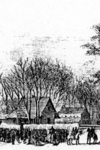
Moses Barber had simply had enough of his cattle going missing. He believed that David Mizell and his friends were periodically stealing from his herd. His rage reached a point where Barber publically declared that if David Mizell set foot on his property again, he would be shot.
On February 21, 1870, David Mizell became the first casualty of the Barber-Mizell Family Feud. He was shot and killed on Barber property near Holopaw, Florida, in Osceola County.
Moses Barber first settled in North Florida in the 1830s. As the Seminoles were pushed to the south, Barber expanded his cattle operation into Central Florida. Some members of the Barber family built homes on the south end of the cattle run, near Fort Christmas. By... click title or here for the full article

Caroline P. Rossetter, at the tender age of 23, listened at the keyhole as a debate took place behind closed doors at the Standard Oil Company office in Louisville, Kentucky. Upon her father’s death, Carrie Rossetter requested that she be allowed to take over his Standard Oil Agency in Brevard County, Florida. That request sparked a heated discussion.
The year was 1921, and women had received the right to vote in the United States just months before. The idea of a woman being able to run a business was preposterous to some.
James W. Rossetter had moved his family to Eau Gallie, Florida in 1902, when Carrie was just four years old. He distributed Standard Oil products by boat up the Banana River to Cape Canaveral. Car... click title or here for the full article
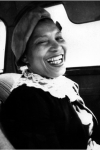
On July 9, 1951, writer, folklorist, and anthropologist Zora Neale Hurston wrote in a letter to Florida historian Jean Parker Waterbury: “Somehow, this one spot on earth feels like home to me. I have always intended to come back here. That is why I am doing so much to make a go of it.”
It would be natural to assume that Hurston was writing about her adopted hometown of Eatonville, Florida. Growing up in Eatonville, the oldest incorporated municipality in the United States entirely governed by African Americans, instilled in Hurston a fierce confidence in her abilities and a unique perspective on race. Eatonville figures prominently in much of Hurston’s work, from her powerful 1928 essay How It Feels To Be Colored Me to her acclaimed 1937 novel Their... click title or here for the full article
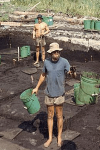
Backhoe operator Steve Vanderjagt couldn’t believe his eyes. After uncovering a round, brownish object, he stopped clearing away the muck and debris to investigate further. When Vanderjagt picked up the object, the two empty eye sockets of a skull were staring back at him.
The year was 1982, and Steve Vanderjagt was working to clear the area around a pond in what would become the Windover Farms subdivision in Titusville, Florida, near the intersection of Interstate 95 and State Road 50. It was quickly apparent that the remains of several very old skeletons had been disturbed.
Jim Swann, the developer of the property, could have made the choice to quietly cover the bones and proceed with construction of his housing... click title or here for the full article







